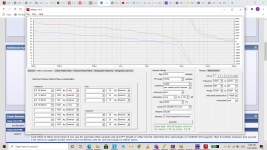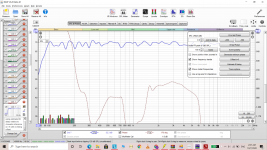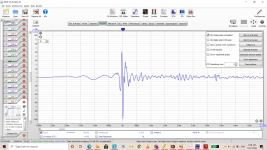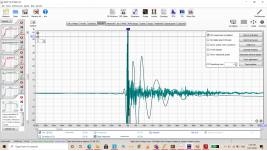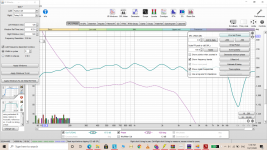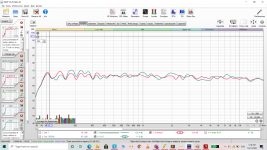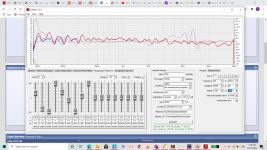Do they now engineer the sound for a small audience that's obsessed with system phase "correction"? 😉My thoughts is before the digital era any audio gear was of 100% minimumphase behavour, and on that gear engineers tried their best to get whatever recording sound as real and natural they could within that gears bandwidth and it worked pretty good back then i think,
Not shure most aware there could be some excess phase differences from unit to unit nowadays even whatever the reference system is and if reference system sound is subjective cleared or tested to perform well or superior that is the reference for the recordings, so will answer no but also remember original recordings are probably of high rates that not always are released to end users other than in lower rates and the higher the rates the less excess phase will happen relative down in the actual audio band coverage for ADC/DAC units.
Last edited:
My thoughts is before the digital era any audio gear was of 100% minimumphase behavour, and on that gear engineers tried their best to get whatever recording sound as real and natural they could within that gears bandwidth and it worked pretty good back then i think,
Thx for the reply BYRTT 🙂
I think that still works well.
It does beg the question what were the frequency and order of the minimum phase rolloffs the studio engineers were listening to, when they were trying to get the recording to sound as real and as natural as possible within the gear's bandwidth.
You know, on bottom end for example ..freq extension differences, and order differences .....sealed subs, vs reflex, vs headphones, etc.
It seems to be able to hear what the engineers heard, we would need a matching set of rolloffs with our systems/speakers....ones that share the same group delay curves. (Obviously ignoring the room for discussion's sake.)
Which is what i think you've been recommending...a low order rollof, to at least increase the probability of a loose match with studios.
I think what may have a big starting impact is how the recording was mixed.
For example, on a mixer we can record the entire acoustic performance on a single mic out in the listening field.
And at the same time make recordings of every individual mic or direct feed, every track being used feeding the mixer.
If i listen to the single mic recording, i feel pretty certain i want linear phase top to bottom on my speakers when i replay. Otherwise i'm adding a layer of group delay.
If i mix all the individual tracks together to liking, without varying the timing between them, and without adding any time based effects like reverb etc, i still want linear phase.
If i change the timing of the tracks relative to each other, then i want the system/speakers that i use for replay, to have the same rolloffs as what i mixed/mastered with.
And your recommendation for low order rolloffs no doubt match the pre-digital age better i think.
The implications of the above seems a little ironic to me ...
that unamplified single mic acoustic recordings(or stereo mics) should benefit more from linear phase than amplified mixed and mastered music.
All this said, the question of whether to use flat phase all the way to bottom is moot for me. I only have so much FIR time available, being non-PC based. So I get some phase rolloff concomitant with mag rolloff like it or not.
It's cool to me, the minutia of time and how it effects our sound.
Constantly learning here ....rightly or wrongly Lol
Last edited:
Hi ,
Just got my DDRC-88A after long time using IIR based 2x8 version of the MiniDSP. I have 4 way DIY speaker which currently used IIR crossover and EQs for correction. was wondering if people find it better to have FIR correcting the phase of each element , or should FIR be used to model also the cross over and EQ?
I can't seem to find a thread which talks about it.
Thanks
Just got my DDRC-88A after long time using IIR based 2x8 version of the MiniDSP. I have 4 way DIY speaker which currently used IIR crossover and EQs for correction. was wondering if people find it better to have FIR correcting the phase of each element , or should FIR be used to model also the cross over and EQ?
I can't seem to find a thread which talks about it.
Thanks
It's interesting from a technical perspective but still unknown what degree of group delay would be audible at the lower end.
Think kind of give up Mark 🙂 and say lets just disagree about this phase thing, but think remember if summed allpass passbands are really of 100% true exactly same minimum phase slope then a mixing situation of tracks on that system have exactly same timing distortion so the rhytm feel would be the same making the track EQ decisions, also why doesnt a true analog EQ sound the same as digital EQ even Q and magnitude is exactly the same for example dial on treble for the true analog EQ and subjective myself sense it alters a tiny little bit into bass area too and same if one dial on bass it is subjective sensed alter a tiny little bit on treble area and that phenomem almost never happen for me using digital EQ except when my system chain is corrected for any excess phase, also notice there is some funny stuff MP verse LP going on for example one thing is linearize a non smooth broad response do not at all sound the same using MP verse LP even magnitude now measure the same, another is sum two MP 2nd order LR slopes and with one inverted they sum flat but as LP slopes one has to remove the inverted feature, another is say you have a ported passband where you plot the dedicated curve of woofer plus the dedicated inverting port curve using MP will look as different curves if same is done using LP, well probably better i stop and lets disagree on subject.Thx for the reply BYRTT 🙂
I think that still works well.
It does beg the question what were the frequency and order of the minimum phase rolloffs the studio engineers were listening to, when they were trying to get the recording to sound as real and as natural as possible within the gear's bandwidth.
You know, on bottom end for example ..freq extension differences, and order differences .....sealed subs, vs reflex, vs headphones, etc.
It seems to be able to hear what the engineers heard, we would need a matching set of rolloffs with our systems/speakers....ones that share the same group delay curves. (Obviously ignoring the room for discussion's sake.)
Which is what i think you've been recommending...a low order rollof, to at least increase the probability of a loose match with studios.
I think what may have a big starting impact is how the recording was mixed.
For example, on a mixer we can record the entire acoustic performance on a single mic out in the listening field.
And at the same time make recordings of every individual mic or direct feed, every track being used feeding the mixer.
If i listen to the single mic recording, i feel pretty certain i want linear phase top to bottom on my speakers when i replay. Otherwise i'm adding a layer of group delay.
If i mix all the individual tracks together to liking, without varying the timing between them, and without adding any time based effects like reverb etc, i still want linear phase.
If i change the timing of the tracks relative to each other, then i want the system/speakers that i use for replay, to have the same rolloffs as what i mixed/mastered with.
And your recommendation for low order rolloffs no doubt match the pre-digital age better i think.
The implications of the above seems a little ironic to me ...
that unamplified single mic acoustic recordings(or stereo mics) should benefit more from linear phase than amplified mixed and mastered music.
All this said, the question of whether to use flat phase all the way to bottom is moot for me. I only have so much FIR time available, being non-PC based. So I get some phase rolloff concomitant with mag rolloff like it or not.
It's cool to me, the minutia of time and how it effects our sound.
Constantly learning here ....rightly or wrongly Lol
Last edited:
Hey guys, i'm really stuck here and need some help.
I bought a minidsp 2x4HD and a CSL calibrated UMIK-1, I recently discovered that Minidsp 2x4HD have FIR filters that i can use, searched for tutorials on how to use Rephase with REW to make the filters
-i start by taking 9 measurements for each speaker.
-i time allign them and vector average them.
-i EQ simulate the response and save the filters.
-i export the vectored response as a text and import it into rephase.
-i import the filters into rephase.
-I then generate lpcm 32 bit Mono impulse response and import it into REW
-using the trace arithmic i multiply the vector response to the impulse reponse(A*B), and generate an excess phase to the corrected response
-i export the excess phase as txt to rephase and fix the phase using filter linearization and paragrephic phase EQ till it s closest to 0 degree from 100 to 20 khz , i import the vectored response and apply the filters again.
-i generate the response to use in minidsp2x4 HD using the allowed 2048 tap and using the bin. format, makig sure that the response in rephase is still good due to the low number of taps.
-i upload the taps into the minidsp and try measuring again, the frequency response is way worse and the phase and impulse aswell.
i ve tried using the IIR filters in minidsp to flatten out the response and using the FIR filters to fix the phase, whatever i try to phase is still very bad after trying to fix it in rephase.
any tips of what i'm doing wrong is appreciated
I bought a minidsp 2x4HD and a CSL calibrated UMIK-1, I recently discovered that Minidsp 2x4HD have FIR filters that i can use, searched for tutorials on how to use Rephase with REW to make the filters
-i start by taking 9 measurements for each speaker.
-i time allign them and vector average them.
-i EQ simulate the response and save the filters.
-i export the vectored response as a text and import it into rephase.
-i import the filters into rephase.
-I then generate lpcm 32 bit Mono impulse response and import it into REW
-using the trace arithmic i multiply the vector response to the impulse reponse(A*B), and generate an excess phase to the corrected response
-i export the excess phase as txt to rephase and fix the phase using filter linearization and paragrephic phase EQ till it s closest to 0 degree from 100 to 20 khz , i import the vectored response and apply the filters again.
-i generate the response to use in minidsp2x4 HD using the allowed 2048 tap and using the bin. format, makig sure that the response in rephase is still good due to the low number of taps.
-i upload the taps into the minidsp and try measuring again, the frequency response is way worse and the phase and impulse aswell.
i ve tried using the IIR filters in minidsp to flatten out the response and using the FIR filters to fix the phase, whatever i try to phase is still very bad after trying to fix it in rephase.
any tips of what i'm doing wrong is appreciated
It's interesting from a technical perspective but still unknown what degree of group delay would be audible at the lower end.
One can test that one self and get a opinion for myself agree wesayso's experience that it spoils the rhytm or lust to automatic foot tapping, have a feel but no proof that because mark100 seems to like flat phase at low end stopband can be because we probaly have some smaller phase distortion in that region caused by any woofer transducer has its resonance sitting inside the passband where for example mids and tweeters have their resonance sitting below and outside the filtered passband, and that inherent resonance phase distortion can probably be reason why some feel it doesnt matter low end stop band is of pure MP, but say we had a live contra bass player non micked and we could magic dial on and change the timing on his low end roll off while he was playing together some other band members then think he would probably kill us because his tight timing consentration relative to band is then lost.
I've done a lot of experimenting with phase and it's audibility. Maybe a little different than what most are trying to get, I wanted my first wave front to be linear in phase with my arrays as it arrived at my ears. So I didn't adjust phase of the speakers alone, but tried to circumvent the room as well.
Arrays have a way of working with the room as far as floor and ceiling reflections go and I tried to absorb as much as I could from first room (wall) reflections to reach that goal.
I managed to get that linear phase at the listening seat, which holds up pretty good over a wider listening area. I first straightened everything out, linear right down to the lowest notes and beyond, even though my frequency curve obviously dropped there.
In listening to various pieces of music, I did notice some songs just felt "off". I do say "felt" for a reason. The timing of the lower notes I felt weren't lined up with what I heard. A strange effect. This could be due to the recording and what not, but when I changed to having my phase follow my frequency curve, like an idealised minimum phase device would have I no longer had those strange experiences. (see the foot tapping comments from BYRTT)
In all honesty, changing from the flat phase way down to zero, in other words straight phase, and this idealised minimum phase following my frequency curve was more noticeable than adding extra phase lag vs minimum phase. Still I preferred the minimum phase for the feel and excitement of the whole experience compared to more conventional group delay of say a minimum phase multi way speaker with one or more crossovers.
If I could build an ideal loudspeaker with a certain frequency curve, it would follow minimum phase. So I just stick to that, and still hold on to getting just that at the listening seat. It has been great fun experimenting with this, even though it took me quite some time to get there.
My goal was to find something that I liked best. That would be the minimum phase behaviour, following the frequency curve of the total speaker, so no extra lag due to crossovers etc. Be it right or wrong, this is what I enjoyed the most and maintained even though I now do have crossovers in place due to using subwoofers for the lowest notes. I understand Mark's point of view, it's what I tried myself. I just enjoy my music better with the minimum phase 'idealised' speaker/room combo.
It took a couple of absorbing panels, DSP and avoiding (or using) floor and ceiling reflections (to my advantage) to get me there, but as said, it has been great fun!
That's probably been my greatest motivation: how much fun is it to listen to? Does it work with the music I like? It does...
I'd say most microphones are wide band minimum phase instruments and I did notice it works very well with some older recordings. With the absence of room queues in the first say ~20 ms, you more and more are getting the feeling of being there. At least, that's my opinion. 🙂
It most certainly is a road I will travel a while longer 😀.
P.S. some of this is discussed in the following thread: The room correction or speaker correction? What can we do with dsp power now availabl
Arrays have a way of working with the room as far as floor and ceiling reflections go and I tried to absorb as much as I could from first room (wall) reflections to reach that goal.
I managed to get that linear phase at the listening seat, which holds up pretty good over a wider listening area. I first straightened everything out, linear right down to the lowest notes and beyond, even though my frequency curve obviously dropped there.
In listening to various pieces of music, I did notice some songs just felt "off". I do say "felt" for a reason. The timing of the lower notes I felt weren't lined up with what I heard. A strange effect. This could be due to the recording and what not, but when I changed to having my phase follow my frequency curve, like an idealised minimum phase device would have I no longer had those strange experiences. (see the foot tapping comments from BYRTT)
In all honesty, changing from the flat phase way down to zero, in other words straight phase, and this idealised minimum phase following my frequency curve was more noticeable than adding extra phase lag vs minimum phase. Still I preferred the minimum phase for the feel and excitement of the whole experience compared to more conventional group delay of say a minimum phase multi way speaker with one or more crossovers.
If I could build an ideal loudspeaker with a certain frequency curve, it would follow minimum phase. So I just stick to that, and still hold on to getting just that at the listening seat. It has been great fun experimenting with this, even though it took me quite some time to get there.
My goal was to find something that I liked best. That would be the minimum phase behaviour, following the frequency curve of the total speaker, so no extra lag due to crossovers etc. Be it right or wrong, this is what I enjoyed the most and maintained even though I now do have crossovers in place due to using subwoofers for the lowest notes. I understand Mark's point of view, it's what I tried myself. I just enjoy my music better with the minimum phase 'idealised' speaker/room combo.
It took a couple of absorbing panels, DSP and avoiding (or using) floor and ceiling reflections (to my advantage) to get me there, but as said, it has been great fun!
That's probably been my greatest motivation: how much fun is it to listen to? Does it work with the music I like? It does...
I'd say most microphones are wide band minimum phase instruments and I did notice it works very well with some older recordings. With the absence of room queues in the first say ~20 ms, you more and more are getting the feeling of being there. At least, that's my opinion. 🙂
It most certainly is a road I will travel a while longer 😀.
P.S. some of this is discussed in the following thread: The room correction or speaker correction? What can we do with dsp power now availabl
Last edited:
@zallou3,
Cant think of other errors than if you use for example other sample rate and FFT lenght or other format rules than the used plugin or miniDSP unit support, then it probaly measure and sounds a bit weird so suggest double check any formatting rules for unit and plugin is within specs.
Cant think of other errors than if you use for example other sample rate and FFT lenght or other format rules than the used plugin or miniDSP unit support, then it probaly measure and sounds a bit weird so suggest double check any formatting rules for unit and plugin is within specs.
@zallou3,
Cant think of other errors than if you use for example other sample rate and FFT lenght or other format rules than the used plugin or miniDSP unit support, then it probaly measure and sounds a bit weird so suggest double check any formatting rules for unit and plugin is within specs.
made sure that everything is withing specs.. attaching a screenshot of the rephase settings i m using, ignore the phase graph please
Attachments
Be aware myself havent any 2x4HD so had to look up the manual at miniDSP site and cant see any big mistake other than notice there is a total of 4096 taps awailable distributed over 4 output channels but no output channel must be set with a number lower than 6 tabs, and the number of taps shall be entered in the lower right corner dialog named "Tabs used:", so will ask have you entered the 2000 tabs number you use there in that lower right corner for one or 2 channels with that dot.bin-file and set the other two or three channels to a number not less than 6 🙂.. hope it can help else suggest try lookup some miniDSP user forum for unit.
i ve tried using the IIR filters in minidsp to flatten out the response and using the FIR filters to fix the phase, whatever i try to phase is still very bad after trying to fix it in rephase.
any tips of what i'm doing wrong is appreciated
From my own experiments correcting phase from a vector average is less successful than doing it from a single position (main listening position).
To try and narrow down what is going wrong, start with just the PEQ. Measure that at your main listening position and see what you have. If it is very different from what REW showed then it could be that you have a big difference between the measurements in the average which will cause any EQ based on it to be less successful. An in room response EQ'd flat as shown in your screenshots will likely sound too bright. Some like it that way but most do not.
When you have the PEQ worked out then try the phase. Start off with a 5 or 6 cycle FDW in REW from the main listening position and use that to generate your excess phase from.
Last edited:
Kessito said:Pos, would it be possible for you to implement this feature? ( import a freq/ phase respone and use this directly to generate the fir?)
Thanks!
You can use Holm Impulse to do that,import frequency domain file and export directly in the time domain (impulse).
Otherwise,you can do that with rePhase,it needs a little more work.(copying manualy the frequency domain)
Or REW.(import frq.domain and export time domain)
Last edited:
REW won't export an IR when the input file is a frequency/phase response.Or REW.(import frq.domain and export time domain)
From my own experiments correcting phase from a vector average is less successful than doing it from a single position (main listening position).
To try and narrow down what is going wrong, start with just the PEQ. Measure that at your main listening position and see what you have. If it is very different from what REW showed then it could be that you have a big difference between the measurements in the average which will cause any EQ based on it to be less successful. An in room response EQ'd flat as shown in your screenshots will likely sound too bright. Some like it that way but most do not.
When you have the PEQ worked out then try the phase. Start off with a 5 or 6 cycle FDW in REW from the main listening position and use that to generate your excess phase from.
i placed the microphone at 1 position and left it there througout this whole experiment.
I left my IIR settings and added a rephase EQ setting that rolls off the upper end a few dbs, and generated that into FIR settings,the frequency response was almost accurate as the A*B generated(attaching pics)
then i generated the excess phase using 6 cycles FDW and 1/6 smoothing.
imported that into rephase and flattened out the phase, generated it into minidsp FIR and tried the same measurement again, phase is still quite off, i'll attach the pics and tell me what you think please.thank you.( red is IIR alone, cyan is after FIR )
Attachments
scttjoplin said:Do they now engineer the sound for a small audience that's obsessed with system phase "correction"
Dolby Lake lp4 (raised cosine)

or
Powersoft - Driving Human Audio Experience
Sorry for the french languageDSP
• Convertisseurs A/D : 24 bit Tandem 96 kHz / Dynamique > 129 dB / THD+N : 0,00056%
• Convertisseurs D/A : 24 bit Tandem 192 kHz / Dynamique > 121 dB / THD+N : 0,0001%
• Quantification interne 40 bits
• Délais : 4 s (sur chaque entrée) + 200 ms (sur chaque sortie)
• Equalisation : raised-cosine, FIR sur mesure, paramétriques IIR : paramétrique, plateaux, passe-tout, passe-bande, stop-bande, passe-haut, passe-bas
• Filtres : Phase linéaire (FIR), hybrides (FIR-IIR) Butterworth, Linkwitz-Riley, Bessel, de 6 à 48dB/oct (IIR)
• Limiteurs : TruePower, tension RMS, courant RMS et pic
• Contrôle du facteur d'amortissement : Active Damping Control : Compensation de la résistance du câble pour un contrôle optimal des haut-parleurs de grave et Sub
ghjj
- Home
- Design & Build
- Software Tools
- rePhase, a loudspeaker phase linearization, EQ and FIR filtering tool
